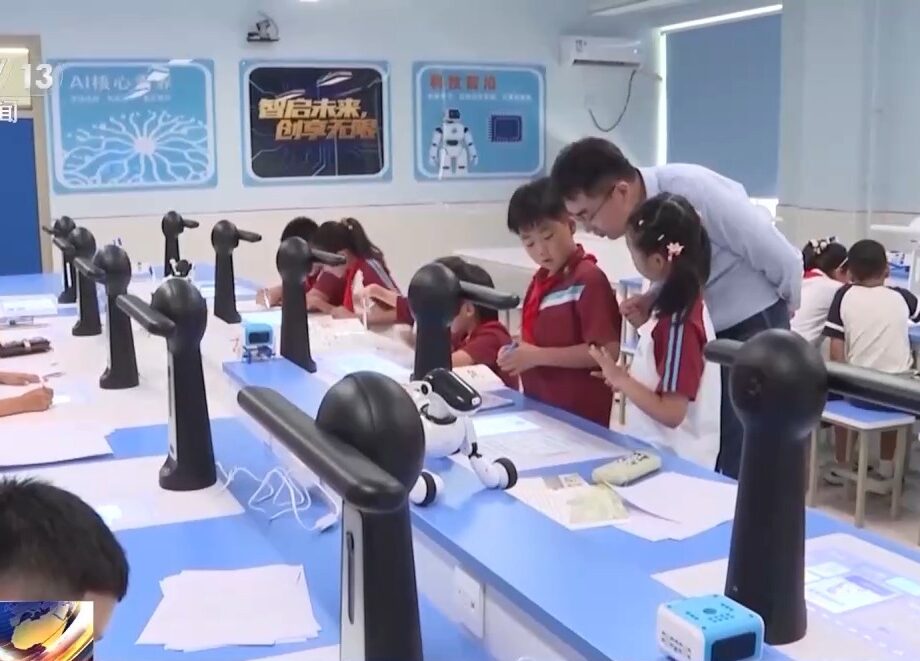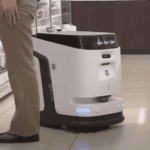A new core subject for the AI age
China is beginning the school year with a sweeping change: artificial intelligence is entering classrooms across the country as a formal part of primary and secondary education. Starting in September 2025, students in cities and counties alike will take structured AI lessons that grow in depth as they advance through school. The plan is part of a national AI plus initiative, a policy push to weave AI into daily life and industry, including education. It aims to build digital fluency from an early age and prepare graduates for a labor market where AI skills are already in demand.
- A new core subject for the AI age
- What the policy requires now
- How the new AI curriculum progresses by grade
- Inside AI enabled classrooms
- Why Beijing is racing to scale AI in education
- Guardrails, privacy and the limits schools set
- Bridging gaps between cities and rural schools
- How this fits into global education trends
- What families and students can expect this year
- At a Glance
In the capital, Beijing has set a baseline that every school must meet: at least eight class hours of AI instruction per academic year. The city’s education commission gives schools flexibility, allowing AI to be taught as a stand alone subject or embedded in science and information technology. Other regions are moving even faster. In Hangzhou, authorities are requiring at least ten hours of AI learning each year across every grade level, from elementary to high school, alongside a formal program to upskill teachers.
This is not simply a curriculum tweak. It is a rethinking of how students learn with and about intelligent systems. The Ministry of Education has laid out an approach that integrates AI into teaching methods, textbooks, and school platforms, and it links the effort to national goals to build a strong education system by 2035. The near term target is universal access to AI education by 2030, with model cities and provinces demonstrating what works and then scaling nationwide.
What the policy requires now
Education officials describe a structure that matches content to student maturity. Young learners will encounter AI through tangible activities that help them grasp what machines can and cannot do. Middle schoolers will practice applying AI concepts to real tasks in class and daily life. High school students will tackle more advanced projects that push toward innovation and design thinking. The aim is to make AI literacy a common competency, like reading or numeracy, that every graduate carries into college or the workforce.
Minimum hours and flexible formats
Beijing’s eight hour requirement functions as a floor, not a ceiling. Schools can go beyond that and many already do through clubs, labs, and after school programs. Hangzhou’s mandate of ten hours per year sets a higher bar and signals the city’s intent to be a leading test bed. Importantly, the policy lets schools blend AI instruction with existing subjects. A primary class might explore image classification during a science unit, while a high school literature class could examine how large language models generate text and where those outputs can mislead.
To help schools move quickly, local authorities have begun to standardize resources. In Beijing, the education commission worked with a digital learning center to compile dozens of lessons that schools can adopt, adapt, and share on a citywide platform. Early numbers point to broad interest, with content reportedly in use by students across many provinces. Alongside content, teacher training is a priority. Regions like Hangzhou are building training centers and networks that connect schools, universities, and technology companies so that teachers can learn practical classroom methods, not just theory.
How the new AI curriculum progresses by grade
The Ministry of Education describes a tiered path from awareness to application. In primary school, students are introduced to simple AI concepts through examples like voice assistants and image recognition. They learn that computers rely on data and rules, and that a model’s prediction is not the same as a correct answer. In junior high, teaching deepens to explain basic ideas of machine learning, including patterns in data and common errors. Students practice critical evaluation, such as checking AI generated answers against trusted sources and identifying bias.
By senior secondary school, students take on practical problem solving. Courses guide them to build and refine simple models, use AI tools for research, and design projects that combine knowledge from multiple subjects. Ethical questions become more central at this stage. Classes address privacy, transparency, fair use of data, and the limits of automation. The structure is designed to build confidence with the tools while also building discipline about when and how to use them.
Ethics and rules on student use
Chinese guidelines stress both innovation and responsibility. Students are encouraged to use AI to brainstorm, organize information, and receive feedback, yet they are prohibited from submitting AI generated content as their own academic work or exam responses. Teachers are asked to model responsible use, explicitly teach how to verify AI outputs, and design assignments that reward original thinking. Officials have described a model that combines teacher, student, and machine, where AI is a helper in the learning process rather than a substitute for learning.
Inside AI enabled classrooms
The policy change is arriving as classrooms experiment with intelligent tools. In some schools, compact AI assistant robots or tablet based agents co teach selected lessons. Their role is to increase engagement, quiz students in small groups, and offer just in time hints without replacing the teacher. Smart platforms that parse large amounts of student work are spreading too. They can grade routine assignments, flag common mistakes, and suggest tailored exercises, giving teachers more time to confer with students who need help.
Technology is also changing preparation and assessment. High school physics teachers, for example, use AI to generate dynamic simulations so students can visualize concepts before lab time. In rural junior high schools, AI enabled grading tools help teachers spot class wide patterns and adjust instruction. Universities have gone even further with AI supported learning companions, offering students around the clock practice and feedback. These pilots are a preview of features that are likely to work their way into upper grades in the years ahead.
Many educators welcome the assistance while drawing a firm line on the role of the teacher. Yuan Wen, president of Shanghai Normal University, has argued that human presence remains at the heart of education, especially when it comes to values and social emotional development.
There will always be a need for a living presence on the podium who can convey the charm of literature with heart and soul.
That view aligns with a common refrain across Chinese schools: use AI to remove busywork and expand access to practice, then reinvest the saved time in conversations, projects, and mentoring that machines cannot replicate.
Why Beijing is racing to scale AI in education
China’s leadership sees education as a foundation for its wider AI ambitions. The country has set targets to be a global AI leader by 2030 and has backed the goal with funding for research, computing infrastructure, and local labs. A national program launched in 2025 committed billions of dollars to AI related projects, including talent development. At the same time, export controls on advanced chips have pushed Chinese institutions to find ways to train models and deploy applications with limited access to top tier hardware. The result is a policy mix that tries to expand use cases across the economy while nurturing domestic talent to reduce bottlenecks.
The education plan reflects that strategy. Officials want students who can think independently, solve problems, and work in teams, and they list these as abilities that AI tools can help develop when used in class. Interest in AI has surged after the rise of domestic models that lowered compute costs and grabbed public attention. Job postings in many fields now cite AI literacy as a plus. In that environment, making AI literacy a basic skill is a way to raise the floor for the next generation while aiming to raise the ceiling for top performers.
Scholars also point to a broader cultural context. Chinese society has a long record of treating science and technology as engines of national progress, and this shapes public support for AI in schools. Fang Kecheng, a communications professor at the Chinese University of Hong Kong, captured this sentiment when he described the national embrace of technology’s potential.
There is a long tradition in China of believing in technology as a driver of national progress.
That enthusiasm is visible on campuses. Surveys report near universal exposure to AI tools among Chinese university students, and many institutions now teach formal AI literacy classes open to non technical majors. The K to 12 curriculum is designed to create continuity, so that students do not encounter AI for the first time only at university or at work.
Guardrails, privacy and the limits schools set
Even as schools adopt AI, authorities and educators set boundaries. Policies bar students from using generative systems to produce final answers for homework or tests. Teachers are tasked with building assignments that prompt original work and with teaching methods to check AI generated information. The guidance encourages a balanced approach. Students can use AI to analyze learning gaps or get practice problems, but not to replace the process of solving problems themselves.
Privacy and over reliance are ongoing concerns. Some classrooms are piloting brain sensing headbands coupled with AI analysis to help teachers see attention patterns and adjust pacing in real time. Advocates say the data can improve instruction. Critics worry about surveillance and pressure on students. Chinese guidance acknowledges the risks and warns against over dependence, urging educators to protect time for open discussion, creative exploration, and reflection. Universities report anxiety among students about AI detection and academic integrity, which points to the need for clear rules and transparent checks.
Experts in teaching and learning argue that the right response is neither a ban nor a free for all. Meifang Zhuo, a researcher who studies student use of AI in higher education, has summed up this view in simple terms.
The goal should not be preventing students from using AI but guiding them to harness it for effective learning and higher order thinking.
That frame carries into the new K to 12 rules. Schools are expected to build students’ judgment about how and when to use AI and to make sure learning remains authentic.
Bridging gaps between cities and rural schools
Equity is a central test for any education reform in a large country. The Ministry of Education has pushed resource sharing and online platforms so that schools with fewer staff or labs can still access quality materials. In Beijing, a shared repository of AI lessons gives schools ready made units that teachers can adapt. Provinces like Zhejiang are building training hubs and designating experimental schools to test techniques before they spread. Data platforms are helping local districts identify where staffing and skills are thin and where to invest.
Teacher training is the keystone. Past rounds of digital education pilots reached millions of educators with AI literacy sessions and produced hundreds of tools to support teaching and professional growth. The new plan expands that work, calling for deeper training tied to day to day classroom practice. Urban rural gaps remain, yet the focus on shared content, remote training, and online support reduces the barrier to entry for under resourced schools.
How this fits into global education trends
China’s push mirrors efforts elsewhere to make AI literacy a standard part of schooling. Education authorities in places like California and Japan have directed schools to consider AI in curricula. European education systems are testing classroom tools and setting guardrails for student use. A growing share of students worldwide now use AI for study help at least weekly. Teachers are experimenting too, using AI to prepare lessons, personalize practice, and track progress, though training and policy support lag in many regions.
What stands out in China is the speed and scope of the rollout. A tiered national framework, minimum time requirements, and shared lesson banks give schools a clear starting point. Public enthusiasm for AI tools is high, and universities have leaned in to formalize AI literacy at scale. The current plan tries to keep the benefits of quick access, while protecting core academic values like originality, accuracy, and human guidance.
What families and students can expect this year
For most students, AI class time this year will be modest in minutes but large in effect. In primary grades, expect hands on activities that demystify how pattern recognition works and why computers need examples. Middle schoolers will likely see AI show up inside existing subjects, for example a science module that teaches how sensors collect data or a civics lesson on how to spot misinformation in AI text and images. High school courses will offer small projects. Students might fine tune a simple model on a classroom dataset, evaluate its results, then write about what improved and what did not.
Families can ask schools a few practical questions: what the AI lessons aim to teach at each grade, how student data will be handled, how teachers check the factual accuracy of AI outputs, and what the rules are for using AI on homework. Good programs will train students to question AI answers, cross check with reliable sources, and explain their reasoning. The best sign that AI is working in class is not more polished homework, it is students who can describe the steps they took, the mistakes they found, and what they changed.
At a Glance
- China begins a nationwide AI curriculum in primary and secondary schools in September 2025, aligned with a national AI plus initiative.
- Beijing requires at least eight class hours of AI instruction per year, delivered as a stand alone class or integrated into science and IT.
- Hangzhou raises the bar with at least ten hours annually across all grades and a teacher training framework.
- The Ministry of Education outlines a tiered path: basic literacy in primary school, applied learning and critical checks in junior high, and project based innovation and ethics in senior high.
- Students are prohibited from submitting AI generated content as academic work or exam responses, with teachers expected to build assignments that reward original thinking.
- Classrooms are piloting AI assistants, smart grading platforms, and, in some cases, brain sensing headbands to adjust instruction in real time.
- Teacher training and shared lesson platforms are central, with cities compiling ready to use AI lessons and provinces building training hubs.
- Officials link the education push to national AI goals for 2030 and broader education modernization plans for 2035.
- Universities have embraced AI literacy at scale, creating continuity from K to 12 into higher education and the job market.
- Authorities aim to expand access while guarding against over reliance, privacy risks, and loss of academic integrity.




